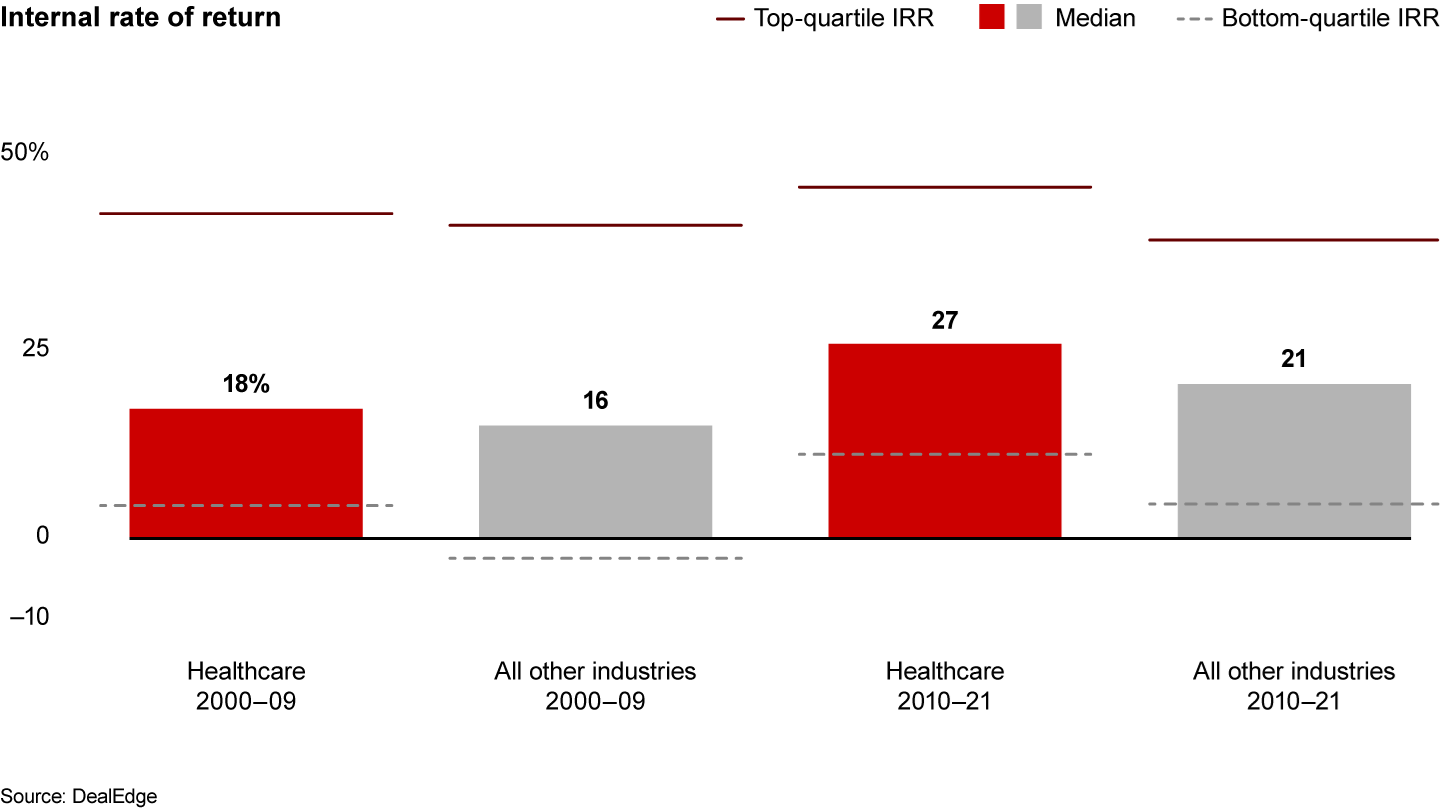Report

At a Glance
- Over the past decade, the median internal rate of return for private equity healthcare deals has outperformed the all-industry median by about 6 percentage points.
- The multiple on invested capital and the write-off rate for healthcare deals over the past 10 years have been similarly attractive.
- DealEdge benchmarks show that healthcare deal value has been driven mainly by strong revenue and multiple growth; margin expansion has been smaller, though in line with other industries.
- Strong returns will likely continue to attract new sources of capital, which will in turn push valuations higher, reinforcing the need for accurate and reliable deal benchmarks.
This article is part of Bain's 2022 Global Healthcare Private Equity and M&A Report
Private equity funds deployed a record amount of capital in healthcare during 2021, and corporate M&A was similarly robust. Investors like the industry’s strong performance and recession-resistant return profile. New sources of capital have increasingly entered the space, pushing up valuations and intensifying competition.
But which factors are most important to the industry’s performance? Reliable market intelligence is critical for making well-informed investment decisions, so to that end, Bain has partnered with CEPRES to bring our DealEdge benchmarks to bear.
Our analysis shows that from 2010 through 2021, the median internal rate of return (IRR) for healthcare private equity deals outperformed those in all other industries by about 6 percentage points—27.5% vs. 21.1% (see Figure 1).
The top and bottom quartiles for healthcare also surpassed other industries. Healthcare’s percentage of deals with multiples on invested capital (MOIC) of less than 1 has been an attractive 17%, compared with almost 26% for all other industries. These returns have been consistent over time, showing less volatility than, say, technology or energy industries. In addition, the write-off rate for healthcare deals is just 2.9%, far lower than the 4.6% for all other industries, indicating less downside risk.


The importance of revenue growth and multiple expansion
Historically, healthcare deal returns have been influenced mainly by revenue growth and multiple expansion (see Figure 2). The median compound annual growth rate (CAGR) for healthcare is 11.1%, compared with 7.6% for all other industries, indicating revenue growth is critical for healthcare value creation. Healthcare companies are finding new streams of revenue through geographic expansion, new technologies and therapeutics, and advanced care models.
As for the robust expansion of multiples over the past decade, this has come despite increasingly higher entry multiples. While the multiple data suggests a favorable exit environment where current owners can sell into a strong market, multiple growth may be harder to achieve in the future as valuations continue to rise. Meanwhile, margin expansion’s contribution to deal value has been relatively small, consistent with other industries.


Margins and revenues will matter more
As evidenced by the many large deals in 2021, healthcare valuations will likely continue to grow. As deals become more competitive and entry multiples rise further, we anticipate that margin expansion and revenue growth will become increasingly important sources of deal value. Determining an attractive paid multiple will require both deep diligence work to build conviction in complex value creation plans, and market insights to help identify pockets of value in this market.
Read our 2022 Global Healthcare Private Equity and M&A Report

DealEdge Sector Study: Healthcare Private Equity 2022
DealEdge® is the private equity industry’s leading provider of deal-level performance and operational analytics. Get groundbreaking deal-level analysis of PE healthcare performance, value creation, and more in our latest report. DealEdge’s inaugural Sector Study covers 1,500 deals across 62 healthcare subsectors, ranging from Retail Health to MedTech. Download now.